1. Markus family thankful for blessings in disguise
Published: October 2014
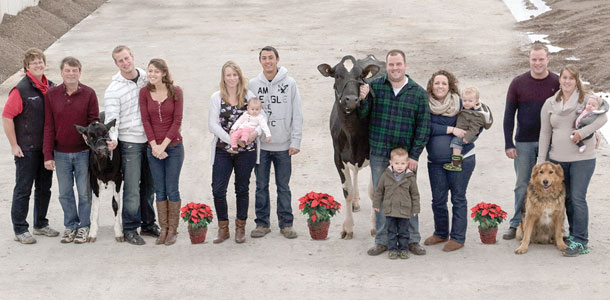
After a fire destroyed their 100-cow herd, tiestall milking barn and feed storage, the Clarence Markus family decided to rebuild Markvale Holsteins with a new freestall barn, milking parlour and bunker silos.
Their apparent faith in God and belief that the experience would be a blessing, not a tragedy, moved countless people in their local community and the dairy industry.
How is everyone adjusting to the new facility?
The cows are doing tremendous. We’ve never shipped so much milk so easily. That’s milk output factoring in the amount of labour.
With the freestall we can get milk now for fall incentives that we couldn’t capture before in the tiestall. As far as cow comfort, the cows are happy and content.
There are a couple of things I wish I could change. One is to install a door in a strategic location so I can move the cardboard bedding from the feed room directly to the bedded pack without having to go outside.
Overall, though, the building is working well and beyond our expectations.
—Clarence Markus, dairy producer, Beachville, Ontario
2. Outstanding Young Farmers display drive toward excellence
Published: February 2014
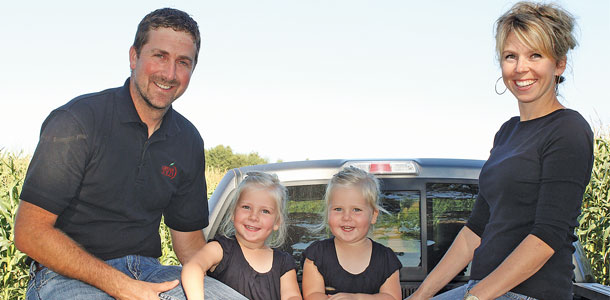
Since returning to the family farm located near Berwick, Nova Scotia, in 2001, James Kinsman has nearly doubled the size of Windcrest Farm Ltd. to 190 registered Holstein milking cows and grown its cropland by fivefold, branching into grain farming.
Nominated by their banker, James and Amanda Kinsman were 2013 finalists in Canada’s Outstanding Young Farmer program. Two winners emerged from the national competition – a grain farmer from Alberta and the Kinsmans.
“The whole experience for us has just been amazing – met great people,” James Kinsman said enthusiastically, adding, “Can’t say enough about the program ... it’s been awesome.”
3. Mountainoak Cheese born from one dairyman’s hobby
Published: June 2014
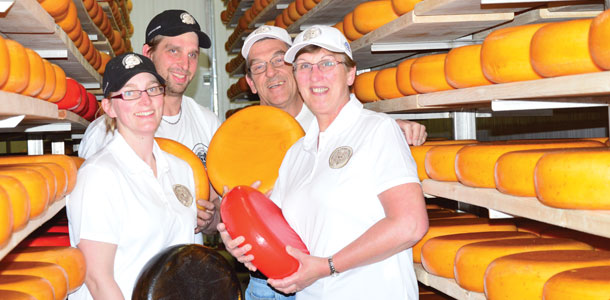
Adam and Hannie van Bergeijk had a thriving business in Holland, operating a dairy farm and cheese-making business. However, with no room for expansion, they decided to move to Canada in 1996.
Over the years, the dairy operation has grown, and now there are 185 milking cows at the home farm, which is managed by their younger son, Arjo, and his wife, Baukje.
Adam and Hannie brought their cheese-making equipment with them when they came to Canada but only made cheese for their personal use. They tried to turn it into a business in 2005, after receiving encouragement from people who had tried it, but ran into miles of red tape.
Six years later they tried again and were successful. The first batch of Mountainoak Cheese was made in July 2012. In a short amount of time, their award-winning cheeses have grown in popularity.
What industry improvements need to be made for more dairy producers to enter the business of on-farm processing?
- There is a lack of education for cheesemakers to be fully equipped for the job. As a member of the Ontario Dairy Council (ODC), we are working on a course for cheesemaking, but it has to be set up in the right structure.
- It would be helpful for new entrants to get financial funding or support to set up a dairy plant and also to have some financial assistance for the time until they reach a breakeven. That might be the biggest hurdle for new entrants.
- Support in marketing. For the most part, farmers are not used to marketing their product.
- The system – boards and committees from various governing bodies – is more oriented to large processors and not used to on-farm processing. It is coming but still far behind.
- An inspection system that is easy to understand for provincial or federal approval with acknowledgement that provincial borders are barriers for selling your product.
- •Last, but maybe most important, how we prepare ourselves for the consequences of the unequal import through CETA. Competition is good but only on a level playing field [not subsidized product for a lower price].
—Adam van Bergeijk, cheesemaker, Wilmot Township, Ontario
4. Robotic milking startup: There doesn’t have to be a story to tell
Published: July 2014
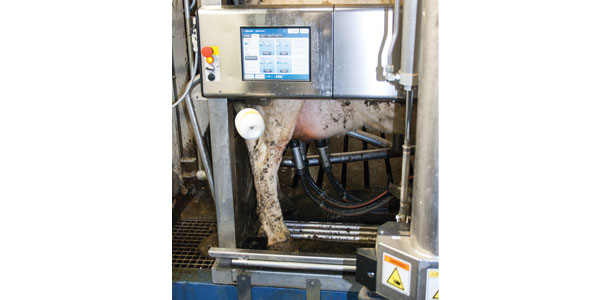
Every producer thinking about or already purchasing a robotic milking system has heard all the stories that can go with a transition – the drama, the tall tales, the truly rough experiences. In reality, most robotic startups won’t have a story to tell.
To ensure yours isn’t one of them consists of planning for the transition and going into the startup period having prepared for the worst. Anything you can do to reduce stress on the animal during the first few weeks will always pay dividends in the long run.
Even simple things like pre-planned schedules and a good startup team can reduce the cows’ stress level.
In terms of additional labour at startup, what qualities should a dairy producer look for when hiring?
“Dairy Farm Help Wanted – Must be self-motivated, willing to work long days and weekends, computer-literate, very patient and have basic mechanical skills.”
You may have had to place an ad to hire help on your dairy farm. With a robotic dairy, not much is really going to change in terms of the types of people you should hire between a robotic and conventional farm. Key traits I look for and our customers look for when hiring that have proven valuable are:
-
Patience. To me, this is one of the biggest assets an employee can bring to any farm. Many of us often do not have enough of it. Patience means your employee will see the value in being respectful of the cows and their slower pace and varying levels of learning.
Specifically in a robotic barn, patience also helps employees cope with the fact the robot is not perfect all of the time. Rushing through work, losing your mind over a fresh heifer in a robot or pushing cows too fast is not doing anyone or anything any good.
-
Self-motivation. Robotic barns are less structured, so the ability to know what needs to be done, get things done thoroughly and be patient when things crop up or change is an important trait. The robot takes away the milking part of dairy work, but there are many other tasks that still need to be completed – and completed correctly.
We want to save labour in these systems and not add labour by constantly having to micromanage employees or re-do work that was hurried or sloppy.
-
Computer and mechanical skills. Being able to operate and sort through computer data, run reports and do basic computer operations is very important in a robot barn.
Combined with basic mechanical repair ability to solve the most common mechanical hiccups improve day-to-day operations of the farm. Robots and their software can be learned fairly easily by someone who comes in with basic computer and mechanical skills.
I have seen some of the most inexperienced people, even from non-agriculture backgrounds, come onto robotic farms and become excellent employees. With patience, self-motivation and basic technical skills, a person doesn’t necessarily need dairy experience.
Being able to train employees in a robotic system, and not have someone with ingrained habits from a different farm causing disruption in the new environment, can often be an advantage when hiring.
—Paul Berdell, consultant, Robotic Milking Integration Solutions
5. Increase pregnancy rateswith robotic milker sensors
Published: June 2014
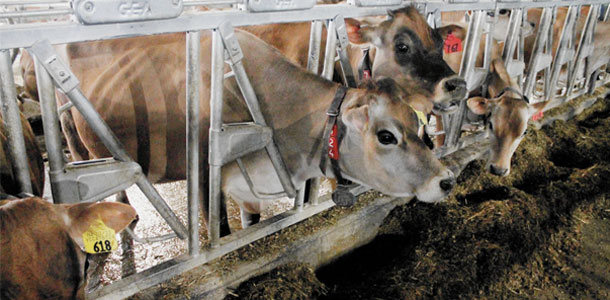
Heat detection and optimum breeding times are key factors for reproductive success. In working with automatic milking systems, producers are able to combine several sensor data points, including activity, rumination and robot visit behaviour.
By using automated monitoring, farmers are able to collect information and find cows in heat even when they are away from the barn – and use this to improve reproduction results on the farm.
What other areas of herd management can be improved with data collection from automatic milking systems?
Early identification of cows at risk of health problems can often reduce both the severity and duration of the condition, which means healthier cows and more milk in the tank.
Utilizing the various sensors and data generated from automatic milking systems allows a producer to make preventative decisions on the health of individual animals. Decreases in rumination and changes in fat-to-protein ratios may indicate a change in digestion and feed intake as well as general health, specifically in early lactation.
A deviation in milk production may also be one of the first changes observed when a cow is feeling less than stellar. Milk temperature monitoring can help to indicate when a cow has a fever.
Somatic cell count helps to improve milk quality and identify subclinically infected animals, while the monitoring of electrical conductivity and colour help to identify early changes in milk composition.
With this data, the software can use algorithims to flag cows with certain attention combinations. Automatic milking system producers then have the ability to make preventative decisions regarding the health and well-being of their animals on a computer or smartphone screen, ensuring a sustainable, profitable and enjoyable future in farming for them and their family.
—Sara McBurney, farm management support, Lely North America.
6. DeLaval doubles sales of automatic milking rotaries in six months
Published: September 2014
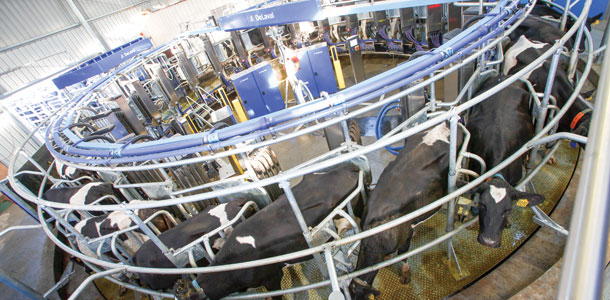
DeLaval more than doubled its sales of automatic milking rotary (AMR) systems. The first commercial AMRs were installed in Australia in 2011 and in Germany in 2013. Since then AMR sales have grown steadily: By the end of 2014, there will be more than 10 installations up and running and delivering customer benefits in four different countries.
When will Canadian dairy producers be able to see this technology?
At DeLaval, with all revolutionary solutions we develop, the market introduction is both methodical and strategic. To the question, “When will Canadian dairy producers be able to see this technology [the DeLaval Automatic Milking Rotary – AMR]?”, the fact is some already have.
This past August, the Progressive Dairy Operators (PDO) conducted a tour throughout Scandinavia, which included a visit to a commercial dairy operation in Sweden, witnessing the AMR in full operation.
Of course, due to varied market demands and requirements by regulatory organizations on a country-by-country basis, DeLaval is wholly committed to taking every step to proactively investigate not only the market demand for such innovations as the AMR but analyze how best to comply with local requirements in a consistent, efficient and cost-effective way, ultimately with both the best interests of the dairy producer and dairy industry at large in mind. We are pursuing this initiative currently.
—Mark Futcher, market development manager, DeLaval Inc.
7. Technology to enhance breeding success, improve economics
Published: June 2014
As technology continues toward better, smaller, faster and cheaper options, the options can be worth a new look. When considering the two major areas of opportunity for a herd’s reproductive success, accurate estrus detection and early pregnancy diagnosis, readily available technology can help tremendously.
Portable ultrasound is the most accurate option to determine early pregnancy, fetal viability, twins and fetal sex. It confirms pregnancy immediately, can verify fetal sex after just two months of gestation and can be up to 95 percent accurate in twin diagnosis.
Once expensive, cumbersome and fragile, machines today are practical and cost-effective.
8. Automatic rail feeders deliver milk to calves in individual pens
Published: July 2014
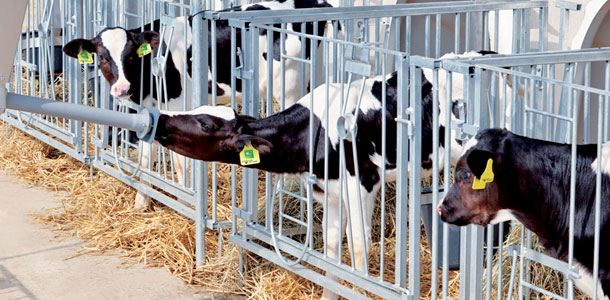
Two different mobile automatic calf feeding systems are entering the marketplace. Each system is capable of feeding calves housed individually. The Calf Rail, manufactured by Förster-Technik, is a mobile feeding apparatus that attaches to a stationary automatic calf feeder with a hose and data line.
With the Uddermatic, developed by Lester Martin, the feeder travels through the barn on a rail. It can feed from one to six calves at a time.
Have any modifications been made to the calf feeder?
We have made a few changes, including one to the heat cable. We are testing that on-farm right now, including here in Canada. So far, it is working fine. We just have to wait for the really cold weather to set in.
We also made a design change to lower the sensor to avoid spillage of milk in front of the calf.
In addition, we changed the software to allow more options for feeding group calves on the same feeder as the Calf Rail. We have successfully tested it to run two Calf Rails on one calf feeder, which means 64 calves on the Calf Rail and 40 more calves in groups fed with two nipples attached to the same feeder.
We will be installing the second calf rail unit in North America in December in Alberta. Plans are still on track to have the product for sale in North America in the middle of 2015.
—Jan Ziemerink, North American representative, Förster-Technik
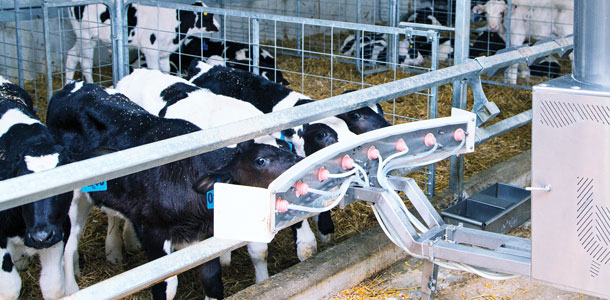
We are anticipating several exciting changes to the Uddermatic rail feeding system. We are presently working on the following:
- Enable the feeder to forward alarms/feeding history to cellular devices
- Diagnose and remedy problems using remote capabilities
- Incorporate video surveillance to assist with troubleshooting after receiving an alarm
These new features will enable farmers to monitor feeding behaviour, assist with training young animals and allow an early diagnosis of problems, all from a distance.
—Lester Martin, owner and developer, Uddermatic
9. Ad libidum but controlled feeding may help calves excel
Published: July 2014
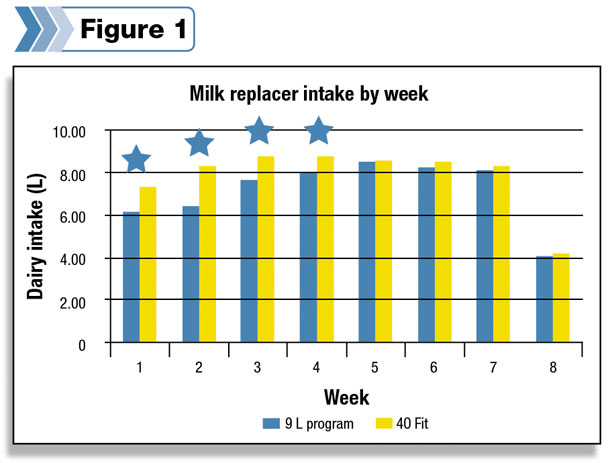
Maximizing the economic return of your calf program depends on the ability to provide the right nutrients and environment based on your calves’ biological needs for growth.
Ad libidum (free-choice) feeding has provided an opportunity to reduce manual labour inputs on-farm while providing an environment for calves to meet their natural feeding behaviour.
Providing ad libidum controlled milk access in the first 28 days may allow calves to excel on the milk nutrients they need. If you are providing ad libidum milk access to your calves, consider weaning groups of calves by gradually decreasing the total litres fed per day earlier on in their feeding program.
By decreasing milk allowance gradually, calves may be stimulated to consume more calf starter to prepare them for a ruminant diet. Thus, improving milk access daily can allow your calves to meet their individual needs for intake to help them excel towards a long lifetime herd production right from the start.
10. Norwell Dairy now Trioliet Automation dealer for Ontario
Published: October 2014
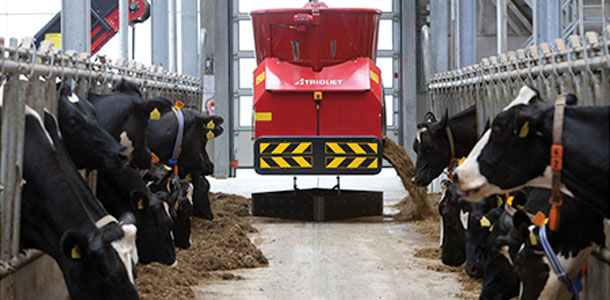
Norwell Dairy is now the exclusive dealer for the Trioliet Triomatic Automatic Feeding System in Ontario. The Triomatic combines vertical TMR mixers with scheduled, automated fresh feed delivery in the cattle barn.
“This system is a natural addition to our product offering as we work to assist our customers to become more efficient and take advantage of labour-saving technologies,” Norwell Dairy Director of Sales and Operations Rick Bauman said in a statement.
The system has been in the European market since 2006, and Norwell will offer sales and service in Drayton, Woodstock, Oakwood and Brinston.
11. Functional conformation yields better cow comfort, welfare
Published: April 2014
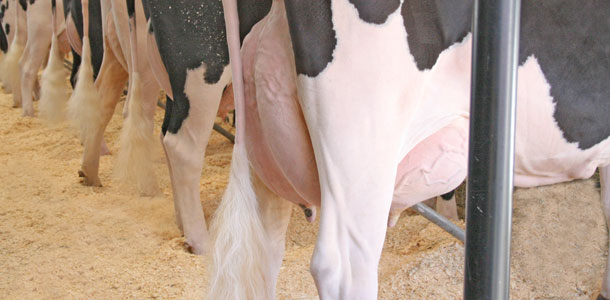
Promoting the health, safety, comfort and longevity of animals in your herd is not just about giving them a proper “feng shui” environment.
It is also extremely important that you use breed improvement tools to ensure the cow is built to last. By classifying a dairy cow, producers are able to identify the functional conformation required to withstand the demands of milk production.
A functionally correct and balanced cow (as defined as the true-type cow in Canada) not only is comfortable in her environment but is also less susceptible to disease, breakdown and can, in turn, produce more milk.
How does function conformation fit into profitability?
In Canada, there are many voluntary breed improvement programs and services into which producers can enroll; one of which is conformation assessment.
Conformation assessment is a comprehensive evaluation of the physical structure or conformation of a dairy animal. This important herd management service identifies strengths and opportunities for improvement that can directly accelerate genetic progress, profitability and longevity when used in combination with corrective mating strategies.
Conformation assessment gives producers an unbiased method to select and manage cows for maximized profitability by identifying animals that are highly productive, more resistant to breakdown or disease and that require low maintenance.
As a herd management tool, producers can identify animals with many weaknesses and choose to eliminate [replace] animals that will cost them more investment in the long term.
Paired with conformation assessment, many dairy producers use the Lifetime Profit Index (LPI) as a primary tool for sire selection in order to achieve genetic improvement for the next generation of animals for a variety of economically important traits.
The LPI has been developed using millions of Canadian cow records, which have been used to identify the traits that are strongly related to overall profitability and to identify bulls which transmit these characteristics to their offspring. These traits include production, durability [conformation], and health and fertility.
—Jeanette Van der Linden, extension and education specialist; Classification and Field Services, Holstein Canada
12. What are realistic expectations for amino acid balancing?
Published: February 2014
Methionine and lysine are the most limiting amino acids (AA) in North America, and several commercial, rumen-protected products are available for use in enriching the cow’s diets with these two AA.
The use of these products is often justified based on an expected, combined response in milk protein, fat and volume. The main reason is because producers can detect these effects fairly quickly and easily by checking the milk tank.
However, focusing solely on milk production and composition is shortsighted. The cow’s response to a diet well balanced for AA goes beyond milk production.
When producers are asked about their experience after balancing the AA of the diets, their response often is about the cow’s improved health and reproduction.
You mentioned detecting the health and reproduction effects of a ration balanced for AA takes longer. What is an estimated time frame for producers to notice changes in these areas?
The time it takes to detect the health and reproduction effects of a ration balanced for AA is related to the metrics of what you are using to evaluate the benefit. In the case of milk volume and composition, the response is easily measured on a daily basis; it is a matter of a few days for the user to be able to gauge the response.
In the case of health, the cow will benefit very fast as well; however, because the metrics are now diseases, it takes longer – a few months – to collect enough meaningful information to demonstrate that the overall herd’s health is better.
In the case of reproduction it takes even longer, perhaps one year. This is because the results will be in terms of better pregnancy retention or less early embryo losses/better pregnancy rates. These metrics are dynamic, and it takes months of data collection to detect the improvements.
In short, from the metabolism point of view, the cow will benefit immediately, but depending on the parameter used to evaluate the effects, detection can extend from days to several months.
—Dan Luchini, manager of ruminant product technical services, Adisseo
13. Seminar to focus on ‘strategies to optimize performance’
Published: February 2014
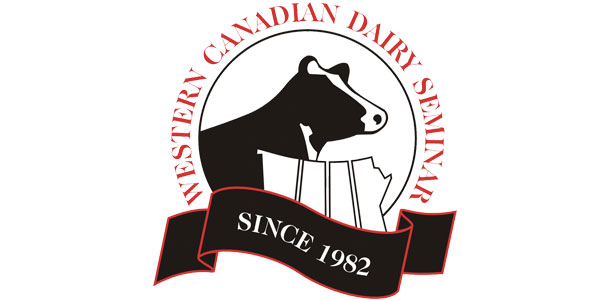
The Western Canadian Dairy Seminar, held annually in Red Deer, Alberta, is designed for people who want to improve their knowledge and decision-making abilities in dairy production and management.
A wide variety of topics are presented, ranging from herd health and calf management to nutrition and reproduction. In 2014, the seminar planned to highlight the people side of the dairy business. With the theme, “Strategies to Optimize Performance,” the seminar focused on ways to make a dairy farm more efficient.
What is the theme of the 2015 seminar?
The 33rd Western Canadian Dairy Seminar (WCDS) will take place in Red Deer, Alberta, from March 10-13, 2015. The theme for the seminar is “Taking Care of Dairy Business.” While at first glance it may appear that the focus would be entirely on the dairy farm, the business of dairying extends far beyond the farm and includes provincial and national dairy organizations, dairy supply companies, research institutes and consumers.
Therefore, we chose this theme because the 2015 WCDS will cover topics beyond the daily management of the dairy farm, broad issues that affect the industry as a whole, and that impact consumers will be discussed.
Topics for 2015 will include the future of supply management, cow welfare and its perception by the general public, raising youngstock, reproduction and feeding management, cow health, and housing and the environment.
Whether you are a producer or involved in the dairy industry in some other manner, we are sure you will find topics of interest to you at WCDS.
—Lorraine Doepel, program chairwoman, Western Canadian Dairy Seminar
14. Activity monitors tailored for tiestall dairies
Published: September 2014
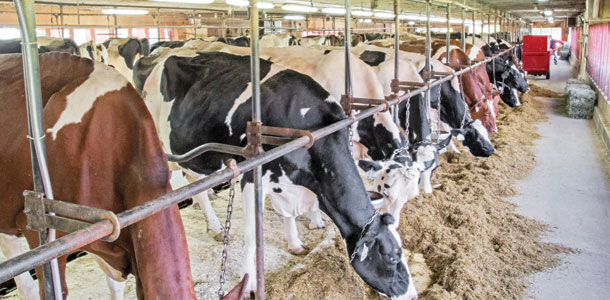
Over the past few years, the adoption rate of activity monitors for heat detection has grown significantly in herds where cows are able to move about freely.
Cows housed in freestalls and open lots are able to display their natural activity, and any deviations from that activity can be detected easily.
Due to the limited activity of cows in a tiestall or stanchion barn, it is more difficult to detect heat in these environments. However, both AfiMilk and EastGen are making activity monitoring systems available to tiestall and stanchion dairies in Canada.
If every cow in Canada were to wear an electronic heat detection device, what could it mean for the national herd’s pregnancy rate?
I expect pregnancy rates to improve with the growth of automated activity monitoring equipment. We’ve already seen insemination rates increase over the last five years by 2 percent in the Ontario herd, which I feel can be contributed to investment in this technology.
All of the herds I work with that maintain annual pregnancy rates above 26 percent use an automated system for heat detection as a part of their reproductive protocol. The next decade is going to be really exciting.
The next generation of activity monitoring systems are not only detecting heats but also are watching the health status of cows as well.
By improving the health monitoring of cows, we will see better conception rates. For these reasons, I believe these systems will become a part of every herd’s reproductive and health management protocol.
—Mark Carson, reproductive solutions manager for EastGen
15. Plett family finds freedom with automation
Published: September 2014
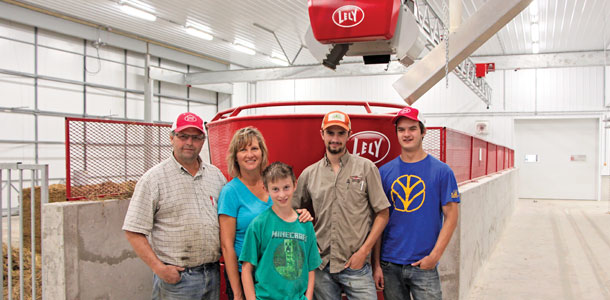
Welden Plett and his family farm 700 acres. They were milking 160 cows when tragedy struck the farm in May of 2013. A barn fire destroyed all of the buildings and a large portion of the milking herd.
The family decided to rebuild capitalizing on the automation available in today’s dairy industry. Their new facility is 52,000 square feet and includes an eight-row freestall barn with a dry and close-up area, a new calf barn with robotic feeders, a feed kitchen and offices. Four robotic milking units were installed along with a robotic feeding system.
How has the herd responded to its new facilities?
The cows have adjusted very well with production being 3 to 4 litres higher then we ever had in our old barn. Feed intake and cow comfort is much better than before. In all of our planning, cow comfort was always the most important, and according to the cows’ response, I think we have achieved that.
With the cell counters on the robot, we have been able to bring our somatic cell count less than 150,000 on a consistent basis and have been less than 100,000 several times already.
We are having issues with our individual bacteria count (IBC) being on the high side and are having a hard time finding the source.
The calf feeder has also worked extremely well. We just weaned our first calves, and they look really good. We have never seen calves grow like that before, but we have also never fed that much milk before.
The Vector [automatic feeding system] has been flawless. It is unbelievable how well it works. It just keeps going and going and really pushes intakes.
We have it pushing up and scanning the bunk every hour and then delivering fresh feed only when it’s needed 24-7. I don’t think I could find a human who would do that without ever forgetting to go or complaining about it.
Overall, it has gone extremely well considering the amount of new technology we have here. PD
—Welden Plett, dairy producer, Steinbach, Manitoba








